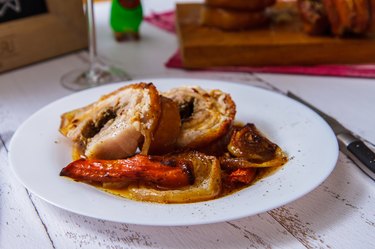
Porketta, porchetta – the variety of names this popular roast has is just a bit less than the cut of pork from which it's made. Pork shoulder, pork butt, pork loin, the entire pig – all have been used in preparation of this popular dish that has a history dating back to 13th century Umbria, Italy. A popular street food with its own celebratory festival, porchetta most likely became porketta when Italian immigrants landed in the upper Midwest to work in the iron mines and found porketta sandwiches in their lunch boxes.
Porketta's Identity Crisis
Video of the Day
The one consistent about porchetta and porketta is that they require meat cut from a pig and butterflied, skin to crown the top and herbs for the stuffing. Together, they create a succulent porchetta or porketta roast that works as a main dish or meat for porketta sandwiches and panini. The distinction is that in the Midwest, porketta usually denotes a sandwich, while porchetta can be either a roast or a sandwich. It's a matter of geography.
Video of the Day
Start With a Roast
Whether you are making porketta or porchetta, you need a piece of pork. Shoulder, butt or top loin all can be roasted to porketta perfection. If you are pals with the butcher, ask to keep the top skin attached and have him score it if you are making porchetta. Take your pork package home and butterfly it, meaning cut it in half but not all the way through. It should open like a book.
Creating the Rub
The secret ingredient is the herb rub or paste each cook creates for the porketta roast. The necessary ingredient is fennel, a mildly licorice-tasting bulb that defines the roast. Rosemary, sage, garlic, lemon pepper and salt are all blended to create the rub. If a paste is desired, add olive oil. Coat the inside of the roast with the blend, close it up, tie it with a butcher's string and let it sit for several hours or overnight to marinate.
Oven Roasting the Porketta
Cooking porketta in the oven gives you control over the heat and internal temperature. Slow roasting at a low temperature yields a roast so tender that it can be pulled apart with a fork. Bring your porketta up to room temperature and then lay it in a baking dish and roast at 450 degrees Fahrenheit for about a half hour. This should crisp up the outside of the roast.
Turn the oven down to 325 and roast for several more hours until a meat thermometer reads 180. During the final hour of cooking, you may want to add carrots, slices of fennel, potatoes and even celery to the baking dish plus a bit of chicken stock. This gravy will be poured on top of the pork when served as a roast or used as a dipping sauce for porketta sandwiches.
Making a Crock-Pot Porketta
Unlike the butterflied pork cut, a porketta made in a Crock-Pot isn't cut open. Instead, the rub is massaged into the exterior of the meat before it's placed in the pot. Some cooks use sliced potatoes on the bottom of the pot, and others cook the pork over onions and celery or sliced fennel. A cup of chicken stock adds moisture and flavor. Cook for eight to 10 hours on low.
The Perfect Porchetta
"Crackling," otherwise known as the skin of the pork, sits atop a porchetta roast and is a cherished delicacy in many countries. If you have the top skin, rub it with oil and sprinkle sea salt over it before you put your porchetta roast in the oven. The initial high temperature blast gets the skin cooking. Lowering the temperature for the next stage cooks the piece of pork underneath.
Before removing it from the oven, give the roast another high temperature blast for a few minutes and then let the roast sit for at least 15 minutes before removing the cracking, cutting it and then slicing the porchetta.